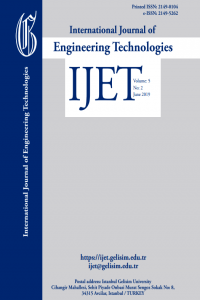Binding Energy and Stability Calculations on Hydrogenated Forms of Substituted Carbazoles as Hydrogen Storage Materials
The aim of this work is to explore the stable hydrogenated forms of carbazole and 9-methylcarbazole molecules by using M06-2X density functional as computational method. Binding energies per hydrogen atom in these hydrogenated forms were calculated by the counterpoise correction procedure. Relative energies, complexation and binding energies for the conformers of dodecahydrocarbazole were also calculated. Stabilities of all the hydrogenated forms were discussed by the analysis of the frontier molecular orbitals.
___
- V. Balema, “Hydrogen Storage Materials”, Material Matters, vol. 2, pp. 1-31, 2007.
- Z. Jiang, Q. Pan, J. Xu, T. Fang, “Current situation and prospect of hydrogen storage technology with new organic liquid”, Int. J. Hydrogen Energ., vol. 39, pp. 17442-17451, 2014.
- P. Chena, M. Zhu, “Recent progress in hydrogen storage”, Mater. Today, vol. 11, pp. 36-43, 2008.
- S.G. Chalka, J.F. Miller, “Key challenges and recent progress in batteries, fuel cells, and hydrogen storage for clean energy systems”, J. Power Sources, vol. 159 (1), pp. 73-80, 2006.
- W. Peschka, C. Carpetis, “Cryogenic hydrogen storage and refueling for automobiles”, Int. J. Hydrogen Energ., vol. 5(6), pp. 619-625, 1980.
- E. Rönnebro, “Development of group II borohydrides as hydrogen storage materials”, Curr. Opin. Solid St. M., vol. 15(2), pp. 44-51 2011.
- K.M. Eblagon, D. Rentsch, O. Friedrichs, A. Remhof, A. Zuettel, A.J. Ramirez-Cuesta, S.C. Tsang, “Hydrogenation of 9-ethylcarbazole as a prototype of a liquid hydrogen carrier”, Int. J. Hydrogen Energ., vol. 35, pp. 11609-11621, 2010.
- N. Kariya, A. Fukuoka, T. Utagawa, M. Sakuramoto, Y. Goto, M. Ichikawa, “Efficient hydrogen production using cyclohexane and decalin by pulse spray mode reactor with Pt catalyst”, Appl. Catal. A, vol. 247, pp. 247, 247-59, 2003.
- R.H. Crabtree, “Hydrogen storage in liquid organic heterocycles”, Energy Environ. Sci., vol. 1,pp. 134-8, 2008.
- F. Alhumaidan, D. Cresswell, A. Garforth, “Hydrogen storage in liquid organic hydride: producing hydrogen catalytically from methylcyclohexane”, Energy Fuels, vol. 25, pp. 4217-34, 2011.
- A. Shukla, S. Karmakar, R.B. Biniwale, “Hydrogen delivery through liquid organic hydrides: considerations for a potential technology”, Int. J. Hydrogen Energ., vol. 37, pp. 3719-26, 2012.
- X. Ye, Y. An, G. Xu, “Kinetics of 9-ethylcarbazole hydrogenation over Raney Ni catalyst for hydrogen storage”, J. Alloy. Compd., vol. 509, pp. 152–156, 2011.
- F. Sotoodeh, B.J.M. Huber, K.J. Smith, “Dehydrogenation kinetics and catalysis of organic heteroaromatics for hydrogen storage”, Int. J. Hydrogen Energ., vol. 37, pp. 2715-2722, 2012.
- F. Sotoodeh, B.J.M. Huber, K.J. Smith, “The effect of the N atom on the dehydrogenation of heterocycles used for hydrogen storage”, Appl. Catal. A-Gen., vol. 419– 420, pp. 67– 72, 2012.
- R. Dennington, T. Keith, J. Millam, GaussView, Version 5.0.9, Semichem Inc., Shawnee Mission, KS, 2009.
- M.J. Frisch, G.W. Trucks, H.B. Schlegel, G.E. Scuseria, M.A. Robb, J.R. Cheeseman et al., Gaussian 09, Revision D.01,Gaussian, Inc., Wallingford CT, 2009.
- S.F. Boys, F. Bernardi, “The calculation of small molecular interactions by the differences of separate total energies. Some procedures with reduced errors”, Mol. Phys., vol. 19, pp. 553-566, 1970.
- M.J. Jenita, A. Antony, M. Prabhu, N. Rajendiran, “Theoretical study of inclusion complexation of tricylic antidepressant drugs with β-cyclodextrin”, Indian Journal of Chemistry, vol. 51A, pp. 1686-1694, 2012.
- I. Fleming, “Frontier orbitals and organic chemical reactions”, Wiley, London, 1976.
- M. Govindarajan, M. Karabacak, A. Suvitha, S. Periandy, Spectrochim. Acta A, vol. 89, pp. 137-148, 2012.
- M.M. El-Nahass, M.A. Kamel, E.F. El-deeb, A.A. Atta, S.Y. Huthaily, Spectrochim. Acta A, vol. 79, pp. 443-450, 2011.
- H. Ullah, A.A. Shah, S. Bilal, K. Ayub, “DFT Study of Polyaniline NH3, CO2, and CO Gas Sensors: Comparison with Recent Experimental Data”, J. Phys. Chem. C, vol. 117, pp. 23701−23711, 2013.
- S. Armaković, S.J. Armaković, J.P. Šetrajčić, L.D. Džambas, “Specificities of boron disubstituted sumanenes”, J. Mol. Model., vol. 19, pp. 1153–1166, 2013.
- K.R.S. Chandrakumar, T.K. Ghanty, S.K. Ghosh, “Relationship between ionization potential, polarizability, and softness: a case study of lithium and sodium metal clusters”, J. Phys. Chem. A, vol. 108, pp. 6661–6666, 2004.
- R.G. Parr, P.K. Chattaraj, “Principle of maximum hardness”, J. Am. Chem. Soc., vol. 113, pp. 1854–1855, 1991.
- P.K. Chattaraj, H. Lee, R.G. Parr, “HSAB principle”, J. Am. Chem. Soc., vol. 113, pp. 1855–1856, 1991.
- ISSN: 2149-0104
- Başlangıç: 2015
- Yayıncı: İstanbul Gelişim Üniversitesi
